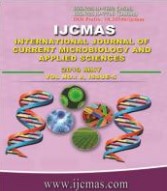


 National Academy of Agricultural Sciences (NAAS)
National Academy of Agricultural Sciences (NAAS)

|
PRINT ISSN : 2319-7692
Online ISSN : 2319-7706 Issues : 12 per year Publisher : Excellent Publishers Email : editorijcmas@gmail.com / submit@ijcmas.com Editor-in-chief: Dr.M.Prakash Index Copernicus ICV 2018: 95.39 NAAS RATING 2020: 5.38 |
For the development of any nation, the females play a significant role. In India, the females comprise 48.18% of the total population. The majority of Indian females reside in the rural areas of our country. The female population of the rural India is the backbone of the rural economy and major drivers in the agriculture sector. They play an important role in poultry farming, goat farming, apiculture and sericulture. The traits required for the workers in the agriculture sectors are inherent in the Indian female population. The qualities of hardwork, concentration, courage, devotion and dedication are ingrained in the women folk of India. Therefore, the agriculture related work is easily done by women. In the sericulture sector, women form a major working force. Sericulture being one of the most important cottage industries can provide employment for the Indian women. It is a labour intensive agro industry and can provide livelihood support to the unemployed rural women. Sericulture can also be taken up as an additional source of income for the people employed in other sectors. It needs low capital investment and greater return. The management and look after is also very simple and less time consuming. It utilizes little space hence, it can provide employment not only to the agriculturists but, also to the landless people and the labourers. Sericulture is the conscious mass-scale rearing of silk producing organisms to obtain silk. It is intensively practiced in the rural areas of Jammu and Kashmir, Himachal Pradesh, Assam, West Bengal, Karnataka and Tamil Nadu; where it creates gainful employment opportunities. It improves the economic conditions of the poor and the small area farmers along with poverty alleviation. In India, women have played and continue to play a crucial role in development of agriculture and allied fields. Unfortunately, the economic condition of women in rural India is critical because they don’t have proper work in their hand. It is the best occupation for women in the changing scenario of their family income. Thus, it is possible to empower women through the development of the sericulture industry. The women participate at a higher rate in activities relating to silkworm rearing, cocoon harvesting, marketing and spinning of the spun yarn. Besides, their involvement is again higher against men in marketing of pupae and cocoon. The similar trend of participation of women is seen in case of mulberry sericulture. It is possible to achieve women empowerment through sericulture industry. The lack of separate rearing house, adequate plantation, improved technological knowledge and times have been major constraint in participation of women in sericulture. As the woman contribute significantly in socio-economic development of rural sector through sericulture, they need to be financially and technologically supported. The development of the sericulture industry and the empowerment of the rural women in India are correlated.
 |
 |
 |
 |
 |